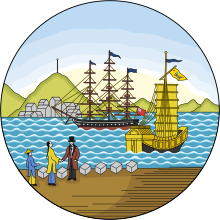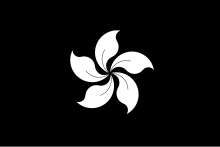Hong Kong flag
| Hong Kong Special Administrative Region Flag (香港特別行政區 區 旗) |
|
|---|---|
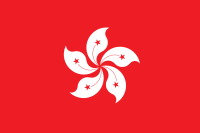 |
|
| Vexillological symbol : |
|
| Aspect ratio: | 2: 3 |
| Officially accepted: | July 1, 1997 |
The Flag of Hong Kong ( Chinese 香港區旗 / 香港区旗 , Pinyin Xiānggǎng Quqi , Jyutping Hoeng 1 gong 2 Keoi 1 kei 4 - "Regional Flag of Hong Kong") - officially flag of the Special Administrative Region of Hong Kong of the People's Republic of China ( 中華人民共和國香港特別行政區區旗 / 中华人民共和国 香港特别行政区 区 旗 ) - was first set on July 1, 1997 . The design of the flag was officially in the third session of the National People's Congress (NPC) of the People's Republic of China on April 4, 1990 accepted. In the 58th meeting of the State Council of the People's Republic of China in Beijing , the legal regulation for the use of the flag passed the State Council and was officially confirmed. The description of the draft, legal regulation for the production and use or misuse and desecration of the flag is recorded in the Regional Flag and Regional Emblem Ordinance of the Basic Law of Hong Kong ("Hong Kong Basic Law").
description

The background color of the flag is red. In the center of the flag is the five-petalled flower of the Bauhinia type Bauhinia × blakeana, known as Hong Kong's city flower, in a stylized white representation. On the five petals of the Bauhinie there are five identical-looking stars that appear on the flag of the People's Republic of China . Therefore, the regional flag of Hong Kong is also unofficially referred to as the "Bauhinie flag" ( 紫荊 花旗 , Zǐjīnghuāqí , Jyutping Zi 2 went 1 faa 1 kei 4 ). The flag was designed by the Hong Kong architect Tao Ho ( 何 弢 , Hé Tāo , Jyutping Ho 4 Tou 1 ).
The Bauhinia × blakeana , colloquially called Hong Kong Bauhinie ( 宮粉紫荊 / 宫粉紫荆 , zǐjīng gōngfěn , Jyutping supply 1 fan 2 zi 2 was 1 or 洋紫荊 , yángzǐjīng , Jyutping Joeng 4 zi 2 went 1 ) or Hong Kong -Orchid tree ( 香港 蘭 / 香港 兰 , xiānggǎnglán , Jyutping hoeng 1 gong 2 laan 4 ), is an endemic Bauhinien species that is native to Hong Kong and originally only occurs there.
Symbolic meaning
The color red as the background color of the flag of the Hong Kong Special Administrative Region symbolizes on the one hand Hong Kong's affiliation with China and on the other hand reflects the traditional, festive meaning of red as an auspicious color. The stylized white bloom of the Bauhinia × blakeana in the middle symbolizes the city of Hong Kong. The two color components of the flag are supposed to represent Deng's constitutional principle of “ one country, two systems ”. The five stars on the petals represent the CCP and the four classes of Mao , the worker , the smallholder , the petty bourgeoisie and the capitalist .
Quote from the chairman of the drafting committee Ji Pengfei on the Basic Law of Hong Kong ( English Hong Kong Special Administrative Region Basic Law Drafting Committee , short BLDC) at the presentation of the flag draft to the National People's Congress ( English National People's Congress , short NPC):
“The regional flag carries a design of five bauhinia petals, each with a star in the middle, on a red background. The red flag represents the motherland and the bauhinia represents Hong Kong. The design implies that Hong Kong is an inalienable part of China and prospers in the embrace of the motherland. The five stars on the flower symbolize the fact that all Hong Kong compatriots love their motherland, while the red and white colors embody the principle of 'one country, two systems'. "
layout
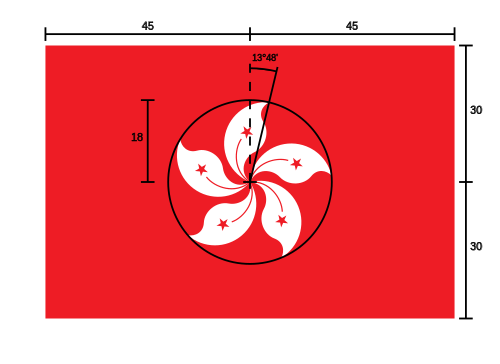
Colours
The colors of the “Bauhinie flag” correspond to the values in the following table.
| Color space | red | White |
|---|---|---|
| RGB decimal | 255, 00, 00 | 255-255-255 |
| RGB hexadecimal | # FF0000 | #FFFFFF |
| CMYK | 0/100/90/0 | 0/0/0/0 |
| HSV | 0 °, 100%, 50% | 0 °, 100%, 100% |
| Pantone | 186 | "safe" |
Sizes
The official sizes of the "Bauhinie flag" correspond to the values in the following table. Different flag sizes should correspond to scaled values of the official sizes.
| Official sizes | Length × width [cm] |
|---|---|
| 1 | 288 × 192 |
| 2 | 240 × 160 |
| 3 | 192 × 128 |
| 4th | 144 × 96 |
| 5 | 96 × 64 |
| 6 - Vehicle flags | 30 × 20 |
| 7 - Flagging for the signature ceremony | 21 × 14 |
| 8 - Desk flags | 15 × 10 |
history
Historic colonial flags
In 1841, during the occupation of Hong Kong by the British Empire , the Union Jack flag of Great Britain was hoisted on the island of Hong Kong for the first time . An official seal was introduced in 1843. The seal design comes from the design office Messrs. Thomson & Son of Wapping in London and shows a local scenery of the Hong Kong coast with sea, mountains, a junk and a three-master in the background. In the foreground is a Chinese trader with henchman and boxes of goods, with a west dressed gentleman cylinder shaking hands. This picture, named after the local area Kwan Tai Lo ( 裙帶 路 / 裙带 路 , Qúndài Lù , Jyutping Kwan 4 daai 3 Lou 6 - "Rockbundweg", coll. Also: 群 大路 , Qúndà Lù , Jyutping Kwan 4 daai 6 Lou 6 , English Kwun-tai-loo - "Great Way") in Victoria City , was probably due to transcription errors and corruption in documents to the "Ar Kwan" Guiding the British Soldier Picture ( 阿 群 帶路 圖 / 阿 群 带路 图 , Ā Qún Dàilùtú , Jyutping Aa 3 Kwan 4 Daai 3 lou 6 tou 4 - "Ar Kwan shows the way-picture").
In 1864 the United Kingdom first introduced a standardized flag system, which allowed the colonial governments of Great Britain to fly their own flags from 1865 onwards. This colonial flags lead at the top of the mast, the so-called Gösch , a Union Jack and the flying side, a badge , each emblem . The government flags, called Blue Ensign , are blue and commercial flags, called Red Ensign , are red. However, Hong Kong never officially held a Red Ensign .
After the seal as a model, a flag design by GC Hamilton with this motif as a badge was rejected by the then Hong Kong Governor Richard Graves MacDonnell and in 1870 the draft proposal of the Colonial Secretary of Hong Kong with the British crown was made using the initial letter "HK" for Hong Kong . In 1871 this flag design was revised and adopted, probably without the letters "HK". There is no historical evidence of what the colonial flag of Hong Kong looked like during this period up to 1876. From 1876 the rejected design from 1868 was revised and colored and finally approved by the Admiralty.
In the colonial period between 1870 and 1997, the "sovereign emblem" (badge) of the colonial flag was changed several times. On January 1, 1959, Hong Kong colonial received its own official emblem from the College of Arms in London . In the same year, the Hong Kong colonial flag was revised and provided with the official Hong Kong emblem . This draft flag has served as the official flag of Hong Kong ever since, from 1959 until it was returned to the People's Republic of China in 1997.

 ? Colonial flag 1959 to 1997, aspect ratio 1: 2
? Colonial flag 1959 to 1997, aspect ratio 1: 2

 ? Trade flag 1959 to 1997, Red Ensign (unofficial)
? Trade flag 1959 to 1997, Red Ensign (unofficial)
Official competition for the flag of the SAR Hong Kong
In search of suggestions for the appearance of the official flag of Hong Kong after it was returned to China, the then government of Hong Kong organized an ideas competition among Hong Kong citizens between May 20, 1987 and March 31, 1988 in order to collect suitable ideas. Eleven personalities from politics, business, science, art and culture were invited to judge the competition. Of the 7147 entries submitted at the time, 4489 flag designs were. Six of these were shortlisted and submitted to the Chinese government's decision-making committee in Beijing. However, none of the competition proposals submitted by Hong Kong citizens were deemed suitable. Therefore, representatives of the Chinese government in Hong Kong asked three suitable local members of the jury to take over the task and submit new designs. These were the sculptor Lou Wen ( 文 樓 / 文 楼 , Wén Lóu , Jyutping Man 4 Lau 4 ), the designer Hon, Bing-wah ( 韓秉華 / 韩秉华 , Wén Lóu , Jyutping Hon 4 Bing 2 waa 4 ) and the architect Tao Ho ( 何 弢 , Hé Tāo , Jyutping Ho 4 Tou 1 ). Finally, on April 4, 1990, Tao Ho's draft flag was adopted by the National People's Congress (NPC).
Tao Ho commented on the flag designs submitted that there were both funny and politically twisted satirical proposals. So there was a case where the hammer and sickle and the dollar sign faced each other. In addition, many designs were disqualified for using copyrighted symbols.
| flag | Period | use | comment |
|---|---|---|---|
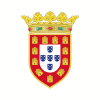 |
1514 - 1521 |
|
Portuguese navy occupies Tamão (today's area of Tuen Mun , Lantau and Kwai Chung ) in 1514. |
 |
1843 - 1868 |
|
Use of the Union Jack flag like the first time at the first occupation of the colony in 1841 on areas of Hong Kong Island . A seal found on a flag from 1870 confirms the use of the flag since the beginning of 1843. |
 |
1862 - 1890 |
|
First variant of the Qing flag (traditional triangular shape). The New Territories belonged to the Chinese Empire until the lease contract before 1898 . The Qing Empire took no imperial flag of 1644 -1862. |
 |
1871 - 1876 |
|
British Blue Ensign with the crown above the lettering "HK". |
 |
1876- 1941 1945 - 1955 |
|
British Blue Ensign with a scenery of Hong Kong Harbor . |
 |
1876- 1941 1945-1955 |
|
Union Jack with a scenery of Hong Kong harbor in the center of the flag. |
 |
1890- 1898 |
|
A second variant of the Qing flag (rectangular shape). The New Territories belonged to the Qing Empire before 1898 . |
 |
1941-1945 |
|
Military occupation by the Japanese Empire during World War II . |
 |
1955- 1959 |
|
British Blue Ensign with a scenery of Hong Kong Harbor. |
 |
1955-1959 |
|
Union Jack with a scenery of Hong Kong harbor in the center of the flag. |
 |
1959- 1997 |
|
British Blue Ensign with the Hong Kong colonial emblem (1959–1997). |
 |
1959-1997 |
|
Union Jack with the colonial emblem of Hong Kong in the flag center. |
 |
1960s– 1999 |
|
Has a stylized, simplified representation of white Bauhinia × blakeana on a magenta background. |
 |
1986 -1999 |
|
Has a stylized white "R" twisted 45 degrees on a dark green background. |
Black Bauhinia flag
In the course of the protests in Hong Kong in 2019/2020 , the democracy movement used a black variant of the flag ( English Black Bauhinia Flag ) as a symbol of the protest. Often the stars (which symbolize the Communist Party of China ) are left out and a wilted Bauhinia flower is sometimes shown.
See also
Web links
- Official Website - Flags and Emblems of Hong Kong (Chinese, English)
- Flag of Hong Kong at FOTW
Individual evidence
- ↑ Oscar Holland CNN: Designed as a symbol of unity, Hong Kong's flag becomes the focus of protest. Retrieved May 28, 2020 (English).
